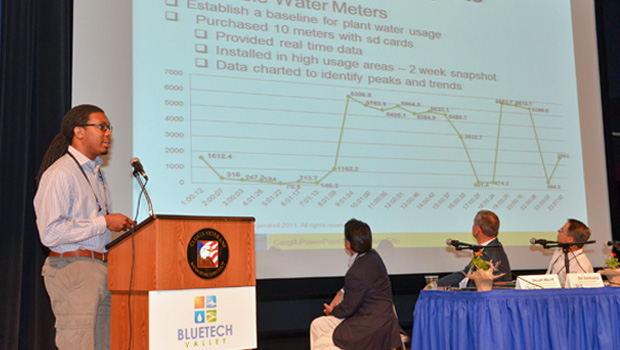More than 150 innovators, entrepreneurs and business specialists with ties to California’s water industry gathered in Clovis this week to share and discuss their vision for water technology at the 2nd Annual BlueTech Valley Conference.
The event was sponsored by a consortium of regional water technology businesses and agencies, including Woolf Farming and Processing, Grundfos, Wells Fargo, Fresno State, the City of Clovis and the California Water Alliance. Fresno State’s Water, Energy and Technology Center (WET Center) is one of the consortium founders and also a co-sponsor of the event.
The conference theme was How Water Efficient Technologies Will Secure Our Future Food Supply.
“Our aim was to create a forum for discussion and inspiration on how new technologies can help sustain and grow the food processing industry in the BlueTech Valley,” said Henrik Skov Laursen, planning committee chair and director of Grundfos Pump Co.
The term “BlueTech Valley” was coined by area business leaders to represent the central San Joaquin Valley water technology industry in the same way that “Silicon Valley” in the Bay Area became known as the center for the computer and software industry in the United States.
“Imagine the drive for new technology, capital investment and entrepreneurship at markets based right outside our door,” Laursen said. “The BlueTech Valley region has the key to unlock this potential.”
The focus of Wednesday’s program was water use efficiency in food processing. To lead discussions of innovation in that area, the conference planning committee invited top executives from some of the region’s leading processing operations, including Stuart Woolf, president of Woolf Farming Co., and Bill Smittcamp, president and CEO of Wawona Frozen Foods.
Woolf and Smittcamp, along with other panelists, outlined innovative steps their processing operations have taken to reduce not only the amount of water used, but the amount of effluent discharged into county and city municipal waste systems.
“We’re always trying to conserve water,” Smittcamp said, recounting a research partnership he developed several years ago with former Fresno State Food Science Professor Gour Choudhury. During a discussion about ways to reduce water use, Choudhury remarked “why not try air?” as a means to peel the skin off the peaches.
That four-word sentence marked the beginning of a three-year research effort that resulted in a new, air-based peeling system. According to Smittcamp, the system saves thousands of gallons of water each day during peak processing at Wawona’s Clovis plant.
Other stories of innovation, trial and error, and success were shared by panelists and conference participants during the afternoon. Thursday focused on water use in the field, with both growers and water technology entrepreneurs sharing ideas for enhancing efficiency in areas such as delivery and reuse.
According to David Zoldoske, director of Fresno State’s Center for Irrigation Technology, the event provided an important opportunity for developers of new water technologies to meet with those in the farming and processing industries who will be the end users of those technologies and systems.
“We’re all sharing a sense of urgency about future threats to our water supply in California,” Zoldoske said. “This provided a great opportunity for networking and the sharing of ideas among the conference participants. I think the collective feeling is that as a community we will be able to solve these problems.”
A highlight of the conference for Fresno State was the formal presentation of a $450,000 grant from the Pacific Gas and Electric Co. (PG&E) for a new AgWaterEnergy Center that will oversee demonstrations of how innovation can save energy and water and preserve water quality in agricultural operations in California’s Central Valley.
Operating under the Center for Irrigation Technology (CIT), the AgWaterEnergy Center will work with manufacturers to design, install and monitor the most advanced water- and energy-saving systems available for demonstration and production on Fresno State’s University Agricultural Laboratory.
Related link:





